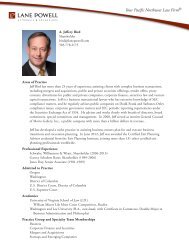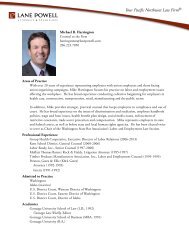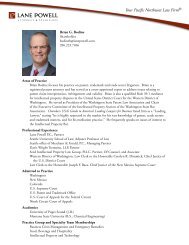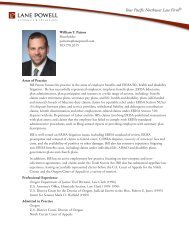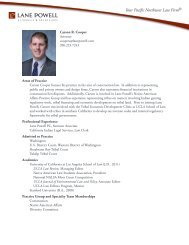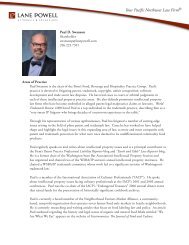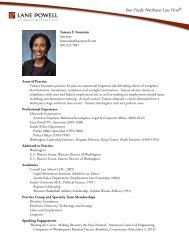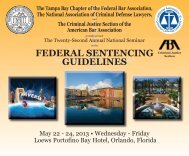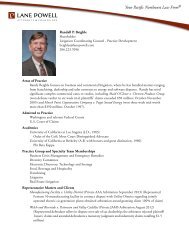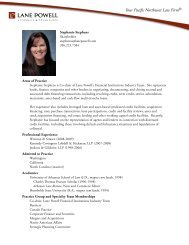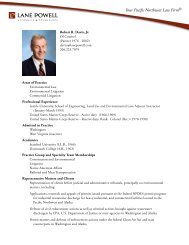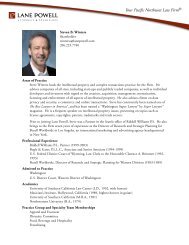portland's unreinforced masonry apartment buildings
portland's unreinforced masonry apartment buildings
portland's unreinforced masonry apartment buildings
You also want an ePaper? Increase the reach of your titles
YUMPU automatically turns print PDFs into web optimized ePapers that Google loves.
32 PORTLAND’S UNREINFORCED MASONRY APARTMENT BUILDINGS: A THREATENED SPECIES?<br />
approximately Magnitude (“M”) 8.7 to 9.2. The most recent CSZ quake occurred 310 years<br />
ago in January, 1700. Geologists now estimate that there is at least a 10 percent probability<br />
of another CSZ, M 9 quake affecting Western Oregon in the next 50 years.<br />
Some casualty<br />
insurers and<br />
commercial real<br />
estate lenders are<br />
becoming hesitant<br />
to insure or loan<br />
on URM <strong>buildings</strong><br />
In 2001, the City of Portland published a database identifying<br />
URM <strong>buildings</strong> in Portland. Of those, by this author’s count, about<br />
200 are <strong>apartment</strong> <strong>buildings</strong>, totaling over 5,200 units and conservatively<br />
worth over $350 million. At least 70 of these URM<br />
<strong>apartment</strong>s are of National Register historic quality. Another 100<br />
historic <strong>apartment</strong> <strong>buildings</strong>, more or less, listed on the database<br />
of the State Historic Preservation Office (SHPO) are of similar <strong>masonry</strong><br />
construction, although not strictly URM’s.<br />
A URM building is vulnerable to damage or collapse in a major<br />
earthquake because such <strong>buildings</strong> generally: (1) are rigid, lacking<br />
flexibility, (2) are not securely connected together, such that their<br />
foundations, exterior walls, floor and roof diaphragms are prone<br />
to separation and (3) lack lateral strength sufficient, given the relatively heavy weight of<br />
<strong>masonry</strong>, to withstand large and sustained horizontal forces (shaking). This damage or collapse,<br />
in turn, will result in the injury or death of many occupants, the loss of a substantial<br />
percentage of Portland’s urban (in-close) rental housing, and the loss of much of Portland<br />
historic fabric.<br />
Some casualty insurers and commercial real estate lenders are becoming hesitant to insure<br />
or loan on URM <strong>buildings</strong> in locales like Portland which have been identified as having<br />
a high earthquake risk.<br />
Portland’s URM <strong>apartment</strong> <strong>buildings</strong> are too important to “write off.” Similar <strong>buildings</strong><br />
in Los Angeles and San Francisco have been seismically retrofitted, albeit at substantial<br />
cost, to anticipate and ameliorate the effects of a major earthquake.<br />
There are tax incentives to the renovation of historic <strong>buildings</strong> including a 10-year (or<br />
with extension 20-year) Oregon historic property tax assessment freeze, a 20 percent federal<br />
historic rehabilitation tax credit for substantial renovation, and Oregon and federal<br />
charitable deductions for building faade (conservation easement) donations. Additional incentives,<br />
especially for URM <strong>apartment</strong> <strong>buildings</strong> that are not of National Register historic<br />
quality, are advisable. Minimal “life-safety” seismic upgrades to URM’s may need eventually<br />
to be made mandatory.<br />
EARTHQUAKE RISK IN WESTERN OREGON AND THE VULNERABILITY OF URM<br />
BUILDINGS<br />
The vulnerability of Western Oregon (as well as coastal British Columbia and Western<br />
Washington) to a large subduction zone earthquake along the Cascadia Subduction Zone<br />
(“CSZ”), the intersection of the subducting Juan de Fuca (Tectonic) Plate and the overriding<br />
North American (Tectonic) Plate, has been known for almost 20 years (Atwater, Musumi-<br />
Rokkaku, Satake, Tsuji, Ueda, and Yamaguchi, 2005). An earthquake in 1700 relieved<br />
hundreds of years of tectonic plate pressure and resultant uplifting of the coastal areas<br />
of Oregon and Washington with one massive fault line correction which resulted in a several<br />
meter drop of coastal areas and incidentally created a “ghost forest” of dead red cedar<br />
trees in a tidal salt marsh near Grays Harbor, Washington. This forest was a key clue




